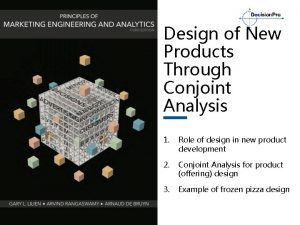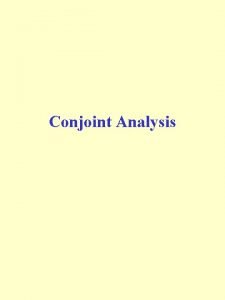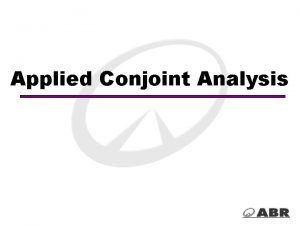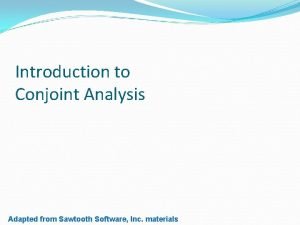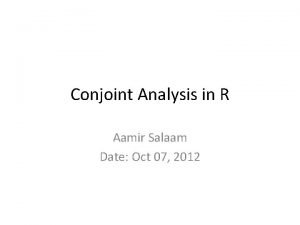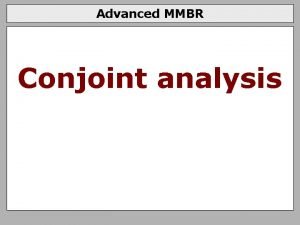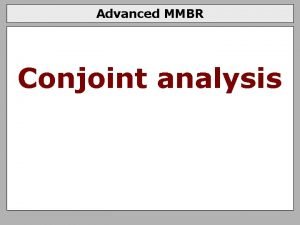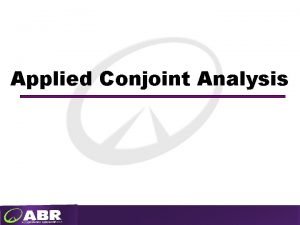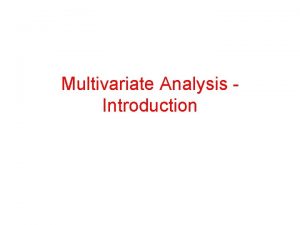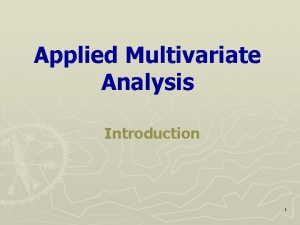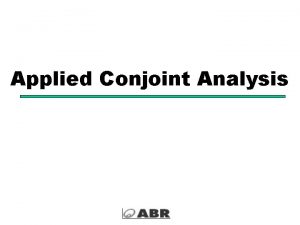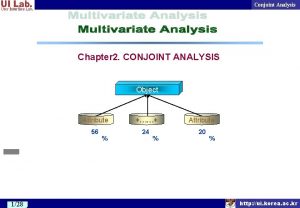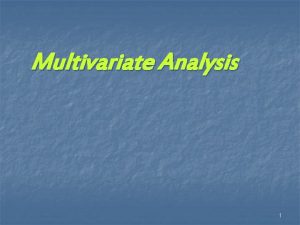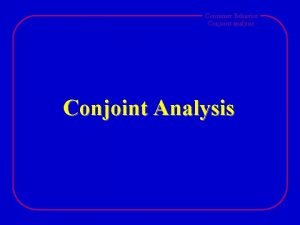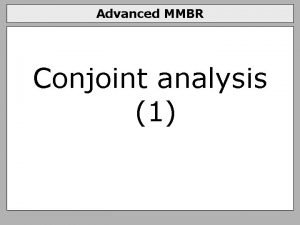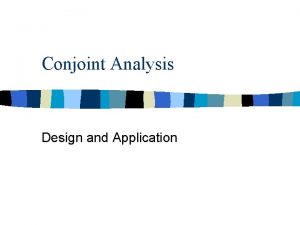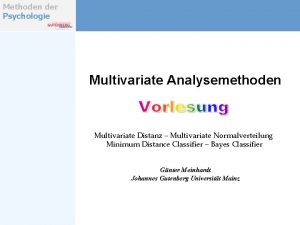Multivariate Data Analysis Chapter 7 Conjoint Analysis What












- Slides: 12

Multivariate Data Analysis Chapter 7 - Conjoint Analysis

What Is Conjoint Analysis? p A Hypothetical Example of Conjoint Analysis n An Empirical Example The Managerial Uses of Conjoint Analysis p Comparing Conjoint Analysis with Other Multivariate Methods p n n Compositional Versus Decompositional Techniques Specifying the Conjoint Variate Separate Models for Each Individual Types of Relationships

Designing a Conjoint Analysis Experiment p Stage 1: The Objectives of Conjoint Analysis n n Defining the Total Utility of the Object Specifying the Determinant Factors

Designing a Conjoint Analysis Experiment (Cont. ) p Stage 2: The Design of a Conjoint Analysis n n Selecting a Conjoint Analysis Methodology Designing Stimuli: Selecting and Defining Factors and Levels p General Characteristics of Both Factors and Levels § Communicable Measures § Actionable Measures p Specification Issues Regarding Factors § Number of Factors § Factor Multicollinearity § The Unique Role of Price as a Factor n Specification Issues Regarding Levels Balanced Number of Levels p Range of the Factor Levels p

Designing a Conjoint Analysis Experiment (Cont. ) p Stage 2: The Design of a Conjoint Analysis (Cont. ) n Specifying the Basic Model Form p The Composition Rule: Selecting an Additive Versus an Interactive Model § The Additive Model § Adding Interaction Effects § An Example of Interaction Effects on Part-Worth Estimates § Selecting the Model Type p Selecting the Part-worth Relationship: Linear, Quadratic, or Separate Part-worths § Types of Part-Worth Relationships § Selecting a Part-Worth Relationship

Designing a Conjoint Analysis Experiment (Cont. ) p Stage 2: The Design of a Conjoint Analysis (Cont. ) n Data Collection p Choosing a Presentation Method § The Trade-Off Presentation Method § The Full-Profile Presentation Method § The Pairwise Combination Presentation Method p Creating the Stimuli § The Trade-Off Presentation Method § The Full-Profile or Pairwise Combination Presentation Methods § Defining Subsets of Stimuli Selecting a Measure of Consumer Preference p Survey Administration p

Designing a Conjoint Analysis Experiment (Cont. ) p Stage 3: Assumptions of Conjoint Analysis p Stage 4: Estimating the Conjoint Model and Assessing Overall Fit n n Selecting an Estimation Technique Evaluating Model Goodness-of-Fit

Designing a Conjoint Analysis Experiment (Cont. ) p Stage 5: Interpreting the Results n n p Aggregate Versus Disaggregate Analysis Assessing the Relative Importance of Attributes Stage 6: Validation of the Conjoint Results

Managerial Applications of Conjoint Analysis Segmentation p Profitability Analysis p Conjoint Simulators p

Alternative Conjoint Methodologies p Adaptive Conjoint: Conjoint with a Large Number of Factors n n Self-explicated Conjoint Models Adaptive/hybrid Conjoint Models

Alternative Conjoint Methodologies (Cont. ) p Choice-based Conjoint: Adding Another Touch of Realism n n A Simple Illustration of Full-profile Versus Choice-based Conjoint Unique Characteristics of Choice-Based Conjoint p p p n Some Advantages and Limitations of Choice-based Conjoint p p n p Type of Decisionmaking Process Portrayed Stimuli Design Estimation Technique The Choice Task Predictive Accuracy Managerial Applications Availability of Computer Programs Summary Overview of the Three Conjoint Methodologies

An Illustration of Conjoint Analysis p Hair et al. (1998), P. 429 -436
 Matt damon
Matt damon Conjoint analysis output
Conjoint analysis output Applied conjoint analysis
Applied conjoint analysis Adaptive conjoint analysis aca
Adaptive conjoint analysis aca Conjoint analysis in r
Conjoint analysis in r Conjoint analysis stata
Conjoint analysis stata Conjoint analysis sample size rule of thumb
Conjoint analysis sample size rule of thumb Conjoint analysis sample size rule of thumb
Conjoint analysis sample size rule of thumb Amce conjoint
Amce conjoint Applied conjoint analysis
Applied conjoint analysis What is multivariate analysis?
What is multivariate analysis? Multiple analysis of variance
Multiple analysis of variance Nature of multivariate analysis
Nature of multivariate analysis
